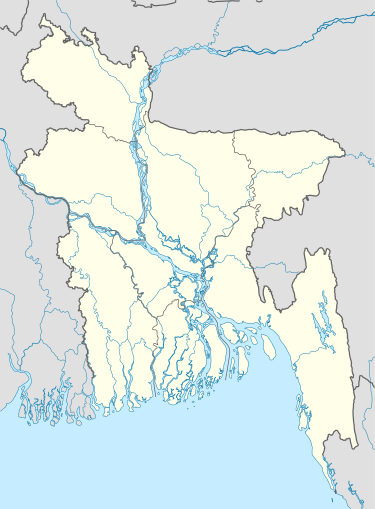Fakirhat Upazila
| Fakirhat ফকিরহাট | |
|---|---|
| Upazila | |
 Fakirhat Location in Bangladesh | |
| Coordinates: 22°46.8′N 89°42.5′E / 22.7800°N 89.7083°ECoordinates: 22°46.8′N 89°42.5′E / 22.7800°N 89.7083°E | |
| Country |
|
| Division | Khulna Division |
| District | Bagerhat District |
| Area | |
| • Total | 160.68 km2 (62.04 sq mi) |
| Population (1991) | |
| • Total | 123,956 |
| • Density | 770/km2 (2,000/sq mi) |
| Time zone | BST (UTC+6) |
| Website | Official Map of Fakirhat |
Fakirhat (Bengali: ফকিরহাট) is an Upazila of Bagerhat District[1] in the Division of Khulna, Bangladesh. It is famous for the medieval "Sixty Dome Mosque" (ষাট গম্বুজ মসজিদ) and the Khan Jahan Ali mazar.
History
During the War of Liberation in the Razakars made a surprise attack on the camp of the freedom fighters at the village of Deyapara in Shuvadia Union in which many people of both sides were killed and wounded. In the village of Jaria many houses were set on fire by the East Pakistani Army as well as Razakars. The famous Leader from Shatshaia village, Jabbar Khan, was killed by Razakars at Jaria.
Geography
Fakirhat is located at 22°46′50″N 89°42′30″E / 22.7806°N 89.7083°E. It has 24,286 households and a total area of 160.68 km².
Demographics
As of the 1991 Bangladesh census, Fakirhat has a population of 123956. Males constitute 51.12% of the population, and females 48.88%. This Upazila's eighteen up population is 67565. Fakirhat has an average literacy rate of 43% (7+ years), compared to the national average of 32.4%.[2] The literacy rate is 49% among males and 36.7% among females.
The population is 123,956, of whom 51.12% are male and 48.87% are female. 71.55% of the population are Muslim, 28.43% Hindu and 0.02% follow other religions.
Economy
Main occupations
38.15% of the population are engaged in agriculture and 16.94% as agricultural labourers, 2.81% in fishing, 6.07% as wage labourers, 14.86% in commerce, 3.01% in transport, 8.3% in services and 9.86% in other occupations.
Land use
There are 10,072.03 hectares of arable land and 5,804.53 hectares of fallow land; single crop 64%, double crop 30% and treble land 6% land control. Among the peasants 33% are marginal, 35% small, 25% intermediary and 7% rich.
Value of land Market
The value of the first grade of land is Tk. 6000 per 0.01 hectares.
Crops
The main crops are Paddy, potatoes, betel leaf and vegetables. The extinct crops and crops nearing extinction are mustard seed, sweet potato and pulses.
Main fruits
The main fruits are coconuts, boroi, areca nuts and bananas.
Fisheries, dairies and poultries
There are 7,463 fisheries, 33 dairies and 47 poultries.
Manufactories
Ice factory 1, Pharmaceutical company 01, oil mill 10, rice mill 20, frozen shrimp preservation 2.
Cottage industries
Bamboo work 85, goldsmith 52, blacksmith 65, wood work 136, potteries 30, tailoring 125 and kantha sewing 15.
Hats, bazars and fairs Hats and bazars are 17; fairs 6, most noted of which are Fakirhat, Lakhpur hat and Attaka Baishakhi Fair.
Main exports
The main exports are coconut, betel leaf, shrimp, and betel nut.
Non-governmental activities
The non-governmental activities in Fakirhat are Sukhee Manush, Drishtanto, Prodipon, Prisam, Viko Bangladesh, Nabolok, asa, brac, grameen bank and CARE.
Health centres
There is an Upazila health complex, eight family planning centres, a satellite clinic and seven community clinics.
Arts and culture
There is a cinema hall, five theatre groups, 30 women's organisations and 25 rural clubs.
Points of interest
The archaeological sites of significance are Shiva Mandhir and Khanjahania Mosque, Sha-Awolia Bag Mazar and Mardan Pir Math.
There are 3 War of Liberation memorialsand 1 memorial structure in Fakirhat.
Administration
Fakirhat has 8 Unions/24Wards, 67 Mauzas/Mahallas, and 87 villages. Fakirhat Upazila, is borderedd by Rupsa and Mollahat Upazilas to the north, Rampal Upazila to the south, Bagerhat Sadar and Chitalmari Upazilas to the east and Batiaghata and Rupsa Upazilas to the west. The main rivers are Rupsa, Bhairab and Chitra. The notable beels are Kalkolia and Foltita.
Fakirhat (Town)
The area of the town is 22.09 km². It has a population of 23476; male 51.93%, female 48.07%. The density of population is 1063 per km2. The literacy rate among the town's inhabitants is 47.4%. The town has one dakbungalow.
The administration of Fakirhat Thana was established in 1869; this was then turned into an upazila in 1983. It consists of 8 union parishads, 67 mouzas and 87 villages.
Transport
Pucca roads cover a length of 61 km (38 miles), semi pucca 10 km (67 miles) and mud roads 563km (350 miles); waterways cover a length of 30-nautical-mile (56 km) and railways 10 km (6.2 miles). There are three railway stations.But at present all railway stations abolished
The traditional means of transport are bullock cart and palanquin. These means of transport are extinct or nearly extinct.
Education
Fakirhat's educational institutions include three colleges, a technical college, 24 non-government high schools, two government high schools, 27 madrasas, 53 government primary schools and 20 non-government primary schools. The noted institutions are Mulghar Government High School (1857) and Bahirdia High School (1892).
References
- ↑ Parthadev Shaha (2012), "Fakirhat Upazila", in Sirajul Islam and Ahmed A. Jamal, Banglapedia: National Encyclopedia of Bangladesh (Second ed.), Asiatic Society of Bangladesh
- ↑ "Population Census Wing, BBS.". Archived from the original on 2005-03-27. Retrieved November 10, 2006.
